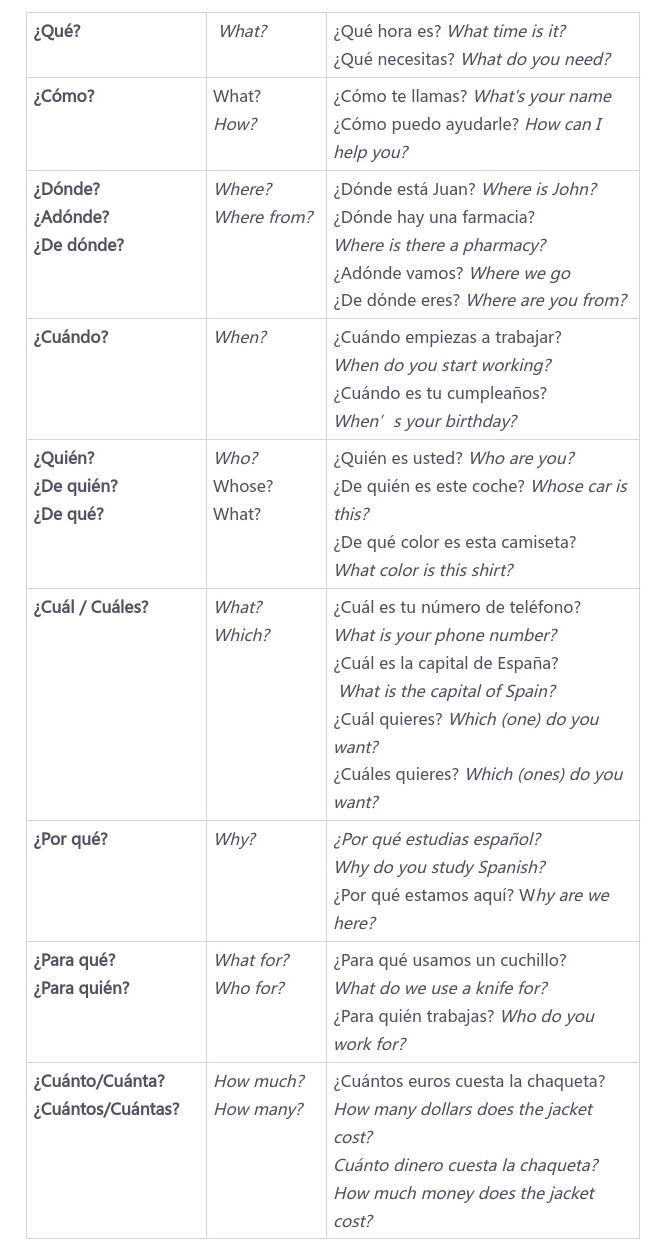Who can learn anything in life without making questions yourself or others? In my experience no one. If you don’t yet know how to ask questions in Spanish, you might get more raised eyebrows than the answers you seek.
When you finish reading this article, you'll be able to make basic questions in the Spanish language in order to keep your curiosity alive (thus your learning).
What’s points we are going through:
- Question words.
- Word order.
- Negative questions.
- Question tags.
- Indirect questions.
1 Question words.
In Spanish, all question words have an accent on them. Two question marks are needed at the beginning and finishing of the question. Let's see what they are and some examples.

2 Word order.
Seldom subject is used in the Spanish language, but if we want to specify it, the most common place to put it’s at the end of the sentence. The same way like in English. Althought in Spanish, question syntax is a lot less strict.
¿Quién eres tú (subject)? ¿Tú Quién eres? Who are you?
¿Dónde están los niños (subject)? ¿Los niños dónde están? Where are the kids?
¿Cómo están ustedes (subject)? ¿Ustedes cómo están? How are you?
¿Come comida mexicana ella (subject)? ¿Ella come comida Mexicana?
3 Negative questions.
When you want to make a negative question, put no before the verb in the same way that you do in statements (non-questions). To answer a question which requires a yes or no answer, just use sí or no.
¿Vienes con nosotros al cine? Are you coming with us to the movies?
Sí / No
¿No vienes con nosotros al cine? Aren’t you coming with us to the movies?
Sí / No
¿Tienes dinero? Do you have money?
Sí / No
¿No tienes dinero? You have no money?
Sí / No
4 Question tags.
In Spanish, we sometimes check whether our facts and beliefs are correct by putting the words: no, verdad and cierto at the end of a comment. But in case of a negative sentence the question tag no is not used.
Eres española. ¿No? ¿Verdad? ¿Cierto? Are you Spaniard, aren’t you?
No eres española. ¿Verdad? ¿Cierto? You are not Spaniard, are you?
Hace calor. ¿No? ¿Verdad? ¿Cierto? It 's hot, isn’t it?
No hace calor. ¿Verdad? ¿Cierto? It’s not hot, is it?
Te gustan las patatas. ¿No? ¿Verdad? ¿Cierto? Do you like potatoes, don’t you?
No te gustan las patatas. ¿Verdad? ¿Cierto? You don’t like potatoes, do you?
5 Indirect questions.
All above sentences are direct questions. We use indirect questions if we want to sound more formal or polite, especially when we are talking to people we don’t know.
Direct question - ¿Dónde está la farmacia? Where is the pharmacy?
Indirect question - ¿Sabe dónde está la farmacia? Do you know where the pharmacy is?
Direct question - ¿A qué hora comienza la reunión? What time does the meeting start?
Indirect question - ¿Puede decirme a qué hora comienza la reunión? Can you tell me what time the meeting starts?
Conclusion
Follow closer to the steps, and make right questions in the Spanish language:
- Ask a question by making your voice go up.
- Use question words.
- Question words always have an accent on them.
- To make a negative question, add no before the verb.
- To check whether your facts or beliefs are correct add ¿no? ¿verdad? ¿cierto?
Well, that’s all. Start practicing typing in comments, any questions or, booking a lesson.
I’m more than happy to dive with you on it.
Thanks for reading!







